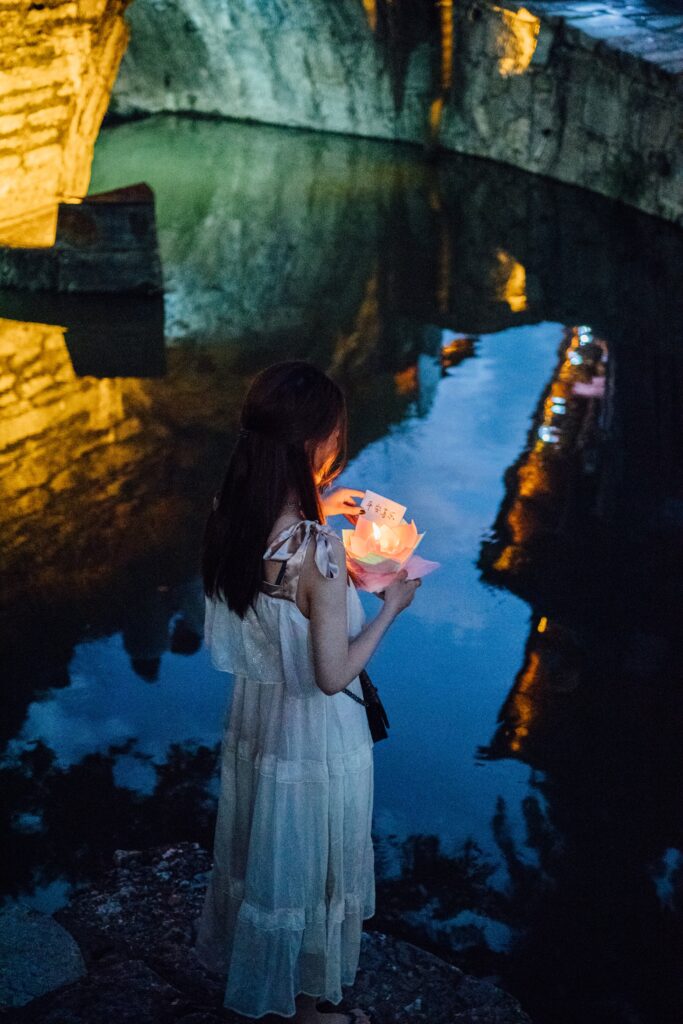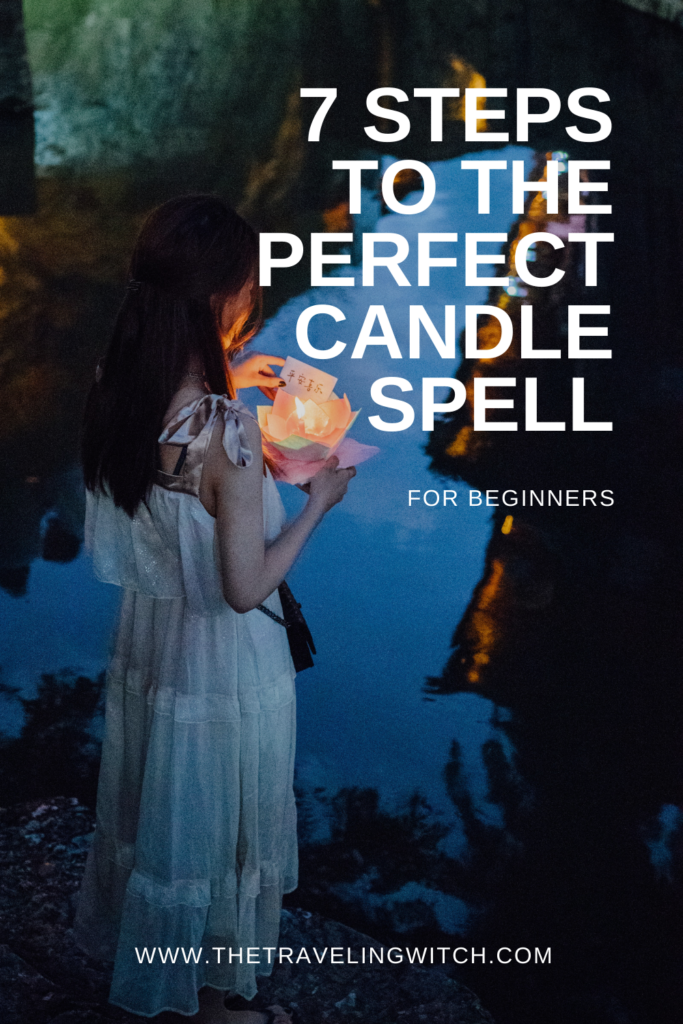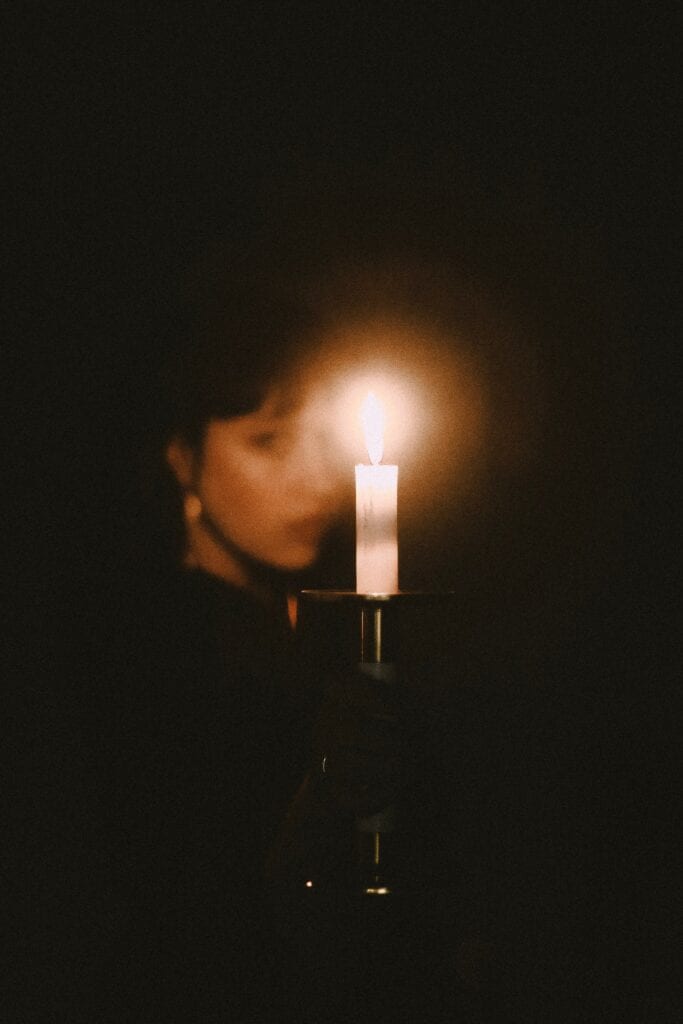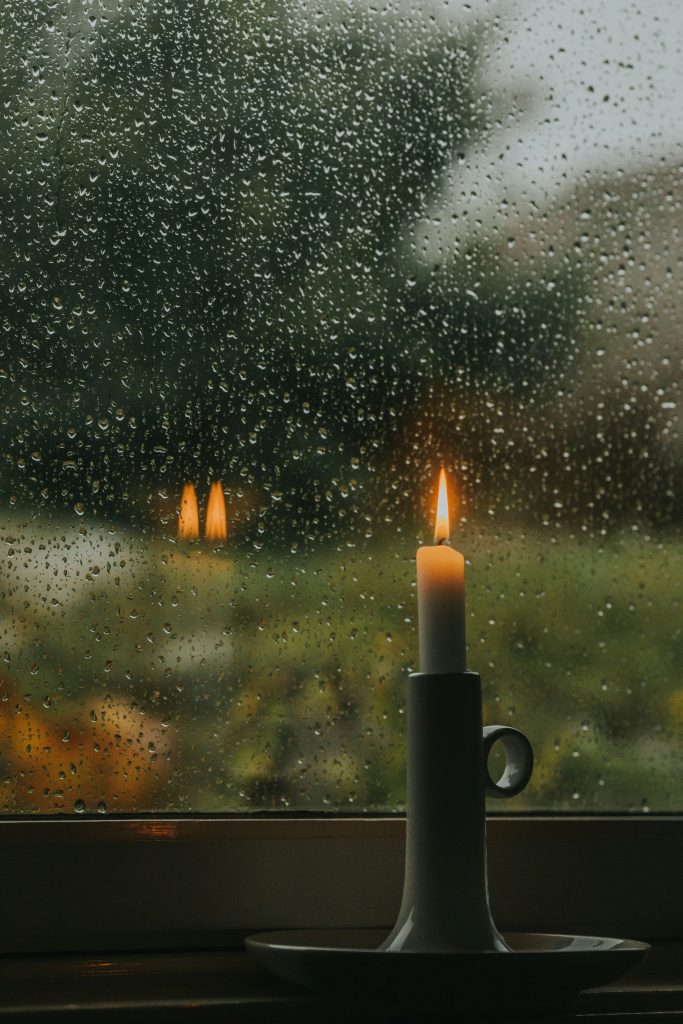Today, we’re getting back to basics. A lot of beginners come to me with absolutely NO idea where to start. I can’t blame them! There’s a huge amount of information available on the internet now and for someone who’s brand new to this world, the sheer volume must be insane. Of course they have no idea where to begin!

Typically, I point people to my free Witchcraft 101 class (you can sign up at the end of this post) to get them started and while that is a great starting point, it’s definitely not a complete primer on how to be a witch. There’s just too much information!
To help fill in those gaps a little more, we’re going to take an in-depth look at one of the most common and underappreciated forms of magic. Candle spells.
Why Candle Spells?
Candle spells are an excellent base form of magic to learn. You can do just about any spell with a candle and candle spells present many opportunities for tinkering and adjusting spells which I think is paramount to the learning process. Because of this, learning basic candle spells gives beginner witches a kind of “blueprint” to work with. Once they master the blueprint, they have a solid knowledge of all the pieces involved, and this allows them to begin substituting, experimenting, and personalizing spells right from the start.
Candle spells also start instilling the theory behind witchcraft early, which speeds future learning and helps bring greater confidence and excitement into their craft.
How To Do A Basic Candle Spell
Step 1: Choose your supplies
Every candle spell begins with a few supplies. You will, obviously, need a candle. The kind of candle you choose is going to depend on the way you plan to use the candle. Glass pillar candles are lovely, but they don’t work if you want to carve symbols or words into your candle. Do you want to dress your candle with oil and herbs?
In addition to making sure that your candle will actually work for the methods you want to use, choosing an appropriate color and scent, what size candle you want (bigger may be fun but they sure do take a long time to burn!), and whether you want the candle to have a particular shape or not.
You’ll also need some way to light the candle, perhaps oil and herbs for dressing the candle, a candle holder, a tool for carving, and any added items you wish to have on your altar or temporary workspace. You might also consider playing some music and dimming the lighting in the room, but if you’re brand new, it’s best to keep things simple.
(Despite the fact that this is step one and seems like an overwhelming number of decisions right up front, you don’t need to worry. Finish reading the article and THEN decide how to proceed with your spell. I explain everything in detail.)
Step 2: Prepare your workspace
The next consideration is your workspace. Remember, we’re working with fire here, so you’ll want to make sure your workspace is fireproof! Set up your workspace somewhere that doesn’t have curtains hanging too near it, don’t put a highly flammable altar cloth on your table, and keep pets and children out of the room. Singed whiskers do not make for happy spells. You might also consider the kind of clothing you want to wear. As pretty as they might be, long flowing gowns and shawls can easily find themselves falling into candle flames. The same is true of long hair. If you have long hair, throw it up into a bun or a ponytail to keep your hair safe.
How you set up your workspace isn’t set in stone. I like to have my candle sit front and center, perhaps with something pretty for decoration on either side. I keep all the tools I plan to use on the right-hand side of the altar and my book to take notes in on the left. I’m typically not a terribly reverent person, so unless the spell is particularly likely to have backlash, I often also have a cup of tea on the altar while I work.
Keep in mind, unless you intend to include a deity in your candle spell, this is not an altar for worship! This is a workspace altar. It is meant to be useful and to be used. There’s no need to treat it as though you are afraid to be disrespectful. It’s all yours!
Step 3: Prepare your candle
Next, it’s time to prepare your candle. This typically happens in three major steps.
1. The first step is carving. As long as the candle is large enough, it should be simple enough to carve. You don’t need a fancy knife for this. A simple butter knife, ice pick, or other vaguely pointy object will do. You can carve words into your candle, identifying your intention or your target, or you can carve symbols into your candles. These symbols can be as simple as a heart or a dollar sign or as complex as a sigil made specifically for the spell you’re casting. The choice is yours. Carving is NOT a mandatory part of the spell. If it’s too much for you during your first spell, you can skip it!
It’s also a good idea to keep backup candles on hand if you’re new to carving candles. I’ve snapped a few candles while carving and if it’s your last candle, it’s a bit of a showstopper.
2. Next is dressing the candle in oil. The kind of oil you use isn’t important. Plain old olive oil will work well if you don’t have anything else to use. Often, this oil has been blessed or enchanted in some way. A simple “may this oil carry my will into reality” can suffice. Many people prescribe a specific direction of applying the oil depending on the type of spell (from the center to the ends for banishing, from the ends to the center for attracting magic) but I find that simply going from top to bottom works just as well for me. Do what feels right for you.
After your candle has been oiled, you can add ground herbs to it. The herbs you will use depend on the spell you’re casting. You don’t need anything complex, though. One or two herbs from your kitchen cupboard can often be made to work for just about any spell. The herbs should be finely ground (no whole peppercorns here) and you can either sprinkle them over the sides of the candle or roll the candle directly in the herb mixture. The herbs will stick to the oil and lightly coat the candle.
At this point, you’ll probably want to set your candle in its candle holder and go clean your hands. I always end up covered in oil and herbs.
Step 4: Light the candle
This is the easy step. Light your candle! It doesn’t matter what you use, matches are cool, lighters are fine, pretty much just use what you have on hand. Some people prefer one method over another, which you’ll figure out over time.
Step 5: Focus on your intention while the candle burns
There are several ways to do this. You can simply meditate or daydream about your intention. You can chant if you feel like creating a small chant about your intention. You can journal, or speak aloud and perhaps record yourself. The choice is yours. Just find some way to focus your energy on the purpose of your spell while it burns. This is where you’re really pouring your energy into your spell and charging all the layers of meaning that you’ve built into your spell, so be sure to spend a fair amount of time on this!
Step 6: Blow out the candle or allow it to burn out
This is a big dispute in some witchcraft circles. Some people feel that blowing out your candle is “extinguishing” your intention and that you should only ever let the candle burn out. I think this is silly. As an air witch, my breath is one of the most powerful tools I have. If anything, blowing out a candle after a spell is a way of releasing my power out into the world through my breath. Do not be afraid to blow out your candles.
Of course, you can also let your candles burn down. Depending on the spell, I will allow candles to burn down occasionally, generally for banishing, cursing, or other such magic. Keep in mind, you should NEVER leave a burning candle unattended! If you’re going to let a candle burn out, you MUST stay with it the entire time. Burning your house down is not a good way to cast a spell.
Step 7: Dispose of the remnants properly
Disposing of spell remains is a rather personal subject. Some witches like to just throw spell remnants in the trash, others into a fire. The only thing I really do not recommend is burying spell remnants or throwing them into natural bodies of water. Unless absolutely everything being buried is biodegradable it’s pretty much just littering.
You can also keep the remnants of your spell for later use if you think you might want to reverse it. Spell remnants should be properly labeled if you intend to keep them for such purposes. You wouldn’t want to be undoing the wrong spell!
And there you have it! All the basic pieces of a candle spell laid out in a simple fashion. These spells are truly about as basic as you can get. If you haven’t tried any spells yet and have perhaps been a bit too intimidated to give it a go, this is a great place to start. Pick an intention, fill in the blanks (and remember, many of them can be omitted) and give it a go!
Are you ready to cast your first spell? Or maybe you’ve cast a few spells but you’re not sure if you’re doing it quite right. Perhaps you stumble over your incantations, you’re not sure if you’re missing steps, or you feel may even feel like something isn’t quite right. If any of this sounds like you, then A Primer In Spell Casting was created with you in mind. In this class, we’re going to be learning how to start casting spells even if you’re a complete and total beginner. Whether you’re looking for a refresher course or you’re wanting to cast your very first spell, this class will take you step-by-step through how to choose your spells, setting yourself up for spell success, casting your spell, and what to do after the casting is over. If you’re ready to actually start practicing witchcraft instead of just reading about it and daydreaming, then A Primer In Spell Casting is for you.
Struggling with your magic?
Take the Quiz to Discover Your #1 Witchcraft Obstacle

Updated on May 15, 2025 by Avery Hart




I have not done candle magic in years ~ thanks for reminding me about how beautiful and powerful it can be! Blessed be
Can a single candle be used multiple times and for different spells?
Hi Ted,
This depends on the spell cast with it. I wouldn’t reuse a candle for purposes that are opposite each other (for example, a banishing spell and a wealth attracting spell). I also wouldn’t reuse a candle used for something quite heavy like cursing. Other than that, it’s perfectly fine to reuse a candle for several spells!
Uhm, question. What’s the tea for? Thanks!
Hi Ellie!
The tea is for me to drink! No special ritual purpose there, it’s just fairly common for me to have a cup of tea lying around somewhere near me. I mentioned that because many people treat their altars as sacred space which, while there’s nothing wrong with that, isn’t always the most comfortable way to work. If it’s not an altar for worship, loosen up!
Thank you for explaining candle spells, I am pretty new to the craft and this is definitely something that I can try!
I like using chime candles or tea lights. Chimes are the quickest and they come in all colors. And I learned to make sure my herbs are well covered by the oil. Amazing how quickly those things ignite.
Chime candles are great! And that’s an excellent point, especially dry herbs can absolutely catch fire if you’re not careful.
Great article! Thank you for simplifying it. I think I was over complicating things 🙂
You wrote about choosing colour of the candle and in many books it is written that I need a candle of particular colour. But is it necessary? Can I just use a white candle?
Hi Katarzyna!
You can use a white candle for pretty much any spell! Candle color can be used to craft a spell, but it is not a necessary component if you do not want to use it.
Thank you so much for writing this post. I have been drawn to candle magic for a few weeks now and this post comes right one time. I do have a question though. I’ve been have a thought about make a “truth” candle. One that I burn when I’m sitting down with company to enchant the atmosphere to be one of honesty and truth. Is that something that’s possible?
Thanks for this. I’ve been wanting to start up my practice again (after a bit of a break) and this seems like a great place to start. 🙂
thank you for all the information. your a very good teacher. i have only one concern that do i need something to protect my self or the house. i dont want any wrong entity to get in the process. what is the best way ? please explane thank you so much.
Will a reversing spell still work if I blow out the candle when I leave the house the candle is too large for me to watch it it takes 48 hours to burn and I don’t have time to sit and wait 48 hours for the candle to burn out so if I put it out and relight it will it still work
Thank you for going back to the basics!!! I know when I first started I didn’t even know how to dress a candle which was a fire hazard in itself… I would sprinkle oil on top of the candle causing huge flames or would just extinguish my candle …..and I spent way to much time on preparing and casting protective circles and way to much time on setting my altar so this refresher course is so refreshing and wonderful!